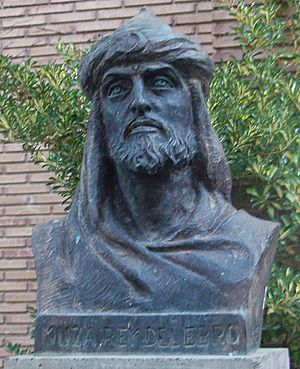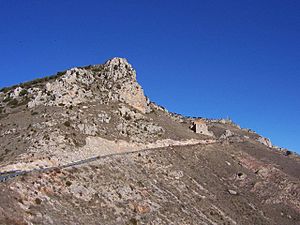Musa ibn Musa al-Qasawi facts for kids
Musa ibn Musa al-Qasawi (also known as Musa the Great; died September 26, 862) was a powerful leader who lived in the 9th century. He was part of the Banu Qasi family, who were Muslims of Iberian descent. Musa ruled a nearly independent area in northern Spain, near the Ebro River. This region was part of Al-Andalus, the Muslim-controlled lands in Iberia.
Contents
Early Life and Rise to Power
Musa ibn Musa came from a family whose ancestor, Count Cassius, became a Muslim after the Muslim conquest of Spain. His mother was also the mother of Basque chieftain Íñigo Arista, making Íñigo Musa's half-brother.
Musa's early life is not well known. It is believed he supported the Basques against the Franks (from France) in the Second Battle of Ronceveaux in 824. This battle helped create the early Kingdom of Pamplona. Later, in 839, his son Furtun ibn Musa led a successful campaign against a "king of the Gallaecians" and destroyed defenses in Álava.
Rebellions and Alliances
Musa ibn Musa first became widely known around 840. He and his half-brother, Íñigo Arista, rebelled against the emir Abd ar-Rahman II. This happened after their lands were attacked and a family member was expelled by governors from Zaragoza and Tudela.
The emir sent his son and a general to fight them. In 842, Musa was part of the emir's army, but he felt he was treated unfairly. So, he rebelled again with his nephew, García Íñiguez of Pamplona. Together, they defeated an army from Córdoba.
Musa and Íñigo joined forces again in 843. They ambushed and captured one of Abd ar-Rahman's commanders. This led to a huge military response from Córdoba, led by the Emir himself. The allies were defeated, and many people near Pamplona were taken as slaves. Another attack in 844 caused more defeats. Musa and Íñigo barely escaped, and many nobles from Pamplona switched sides to Córdoba.
After this, Musa submitted to the emir. In November 844, he helped defeat a large army of Vikings who had attacked Seville. However, he rebelled again the next year. When the emir's son, Muhammad, captured Tudela, Musa submitted once more. He offered his sons as hostages and visited the emir's court. Musa was forced to submit again in 846 and 847. In 850, Musa and Íñigo rebelled together again, with Musa's son Isma'il ibn Musa playing a key role.
"The Third King of Spain"
The years 851 and 852 were very important for Musa ibn Musa. His half-brother and ally, Íñigo Arista, died. The emir, Abd ar-Rahman II, also died. Musa won a great two-day battle against Basque or Gascon forces near Albelda.
The next year, Musa's power was officially recognized. The new emir, Muhammad, named Musa the Wāli (governor) of Zaragoza and the Upper March of Al-Andalus. The next ten years were the peak of his power. He controlled important cities like Zaragoza, Tudela, Huesca, and Toledo.
He created what was like a small kingdom, stretching from Nájera to Zaragoza and Calatayud. People even called him "The Third King of Spain", seeing his power as equal to the emirate of Córdoba and the Kingdom of Asturias.
In 854, Toledo rebelled, supported by Ordoño I of Asturias and García Íñiguez. Emir Muhammad launched a campaign, and Musa likely fought for Córdoba. In 855, Musa led an attack on Álava, a part of the Kingdom of Asturias. In 856, he led his own expedition against Barcelona and Terrassa.
Around 859, Musa's son Lubb ibn Musa was made governor of Toledo. That same year, Musa allowed Vikings to pass through his lands to attack Pamplona. There, the Vikings captured Musa's nephew, García Íñiguez, and demanded a large ransom. This made relations between Musa and García worse. García then joined with Ordoño to attack Musa's lands. This led to a second battle at Albelda. The Christian forces defeated Musa badly, killing his son-in-law and forcing Musa to flee. This victory was later remembered in Christian stories as the legendary Battle of Clavijo.
Decline and Death
The Christian victory at Albelda marked the end of Musa's independent rule. In 860, Emir Muhammad removed Musa as governor. The emir personally led an army through Musa's lands in a month-long campaign against Pamplona. During this, Prince Fortún Garcés of Pamplona was captured.
In 861, Muhammad made Musa play a lesser role in a campaign against Barcelona. The next year, 862, Musa tried to regain his power. He led a military show of force against his son-in-law, Azraq ibn Mantil. Musa attacked Guadalajara, but he was badly wounded and could not ride a horse. He went back to Tutila (Tudela), where he died on September 26, 862.
Family
Musa ibn Musa married a daughter of his half-brother Íñigo Arista. He also married his cousin Maymuna, who was the mother of his younger son Isma'il ibn Musa. The mothers of his other sons, Lubb, Mutarrif, and Furtun, are not known. He had at least two daughters. One, Auria, was married to a Basque prince named Garcia, who was killed at Mount Laturce. The other daughter was known as "the most beautiful girl in Al-Andalus" and married Azraq ibn Mantil.
Legacy
After Musa's death, his family was not as powerful for about ten years. They did return to rule a smaller area for another fifty years. However, their position between the growing power of the caliphate in the south and the Christian kingdoms in the north became too difficult. After three generations, Musa's great-great-grandsons were removed, sent away, or killed by the 920s. The last parts of Musa's independent rule disappeared. His nearly independent rule showed what would happen later with other rebel leaders and the smaller Taifa kingdoms.
See also
 In Spanish: Musa ibn Musa para niños
In Spanish: Musa ibn Musa para niños



